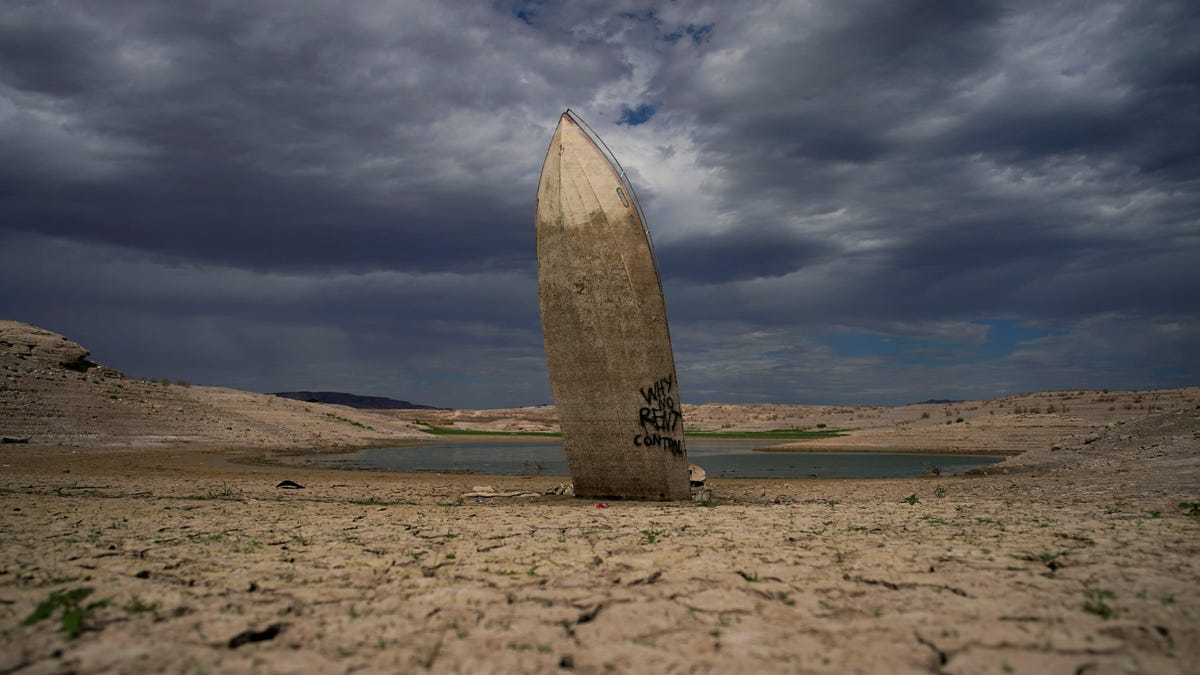Shocking Photos Show Lake Mead's Historically Low Water Levels - 4 minutes read

Stranded boats, desiccated fish, and no water on cracked ground that once made a shoreline. That’s the new business-as-usual for Lake Mead, where the West’s punishing drought and chronic water overuse have combined to render the lake almost unrecognizable as water levels continue to plummet.
As of Tuesday, the lake’s water level was sitting just below 1,042 feet (317.6 meters) above sea level. That’s significantly lower than its levels last year on the same date (just over 1,068 feet [325.5 meters]) and in 2020 (1,086 feet [331 meters]). The lake’s historic high was 1,225.44 feet (373.5 meters), reached in the mid-1980s, but the past few months have brought Lake Mead down to historic low levels not seen since the lake was created in the 1930s.
Lake Will Continue to Lose Water for Months
Lake Mead is not done receding. A government forecast released in May projects that the lake will continue dropping throughout the rest of this year, reaching a worrisome low of 1,037.6 feet (316.2 meters) in December before coming back up. After a few months of respite, the lake will go right back to falling again until September 2023, when officials project it will reach under 1,024 feet (312.1 meters).
Life Changing on the Lake
The plunging water levels have meant a big shift in life on the lake, which is a hotspot for tourism and recreational activities like boating and fishing. Swaths of the shore that were once underwater are now plainly visible; officials say that roughly 20 feet (6 meters) of shoreline becomes visible with each foot the overall water level loses. Tourists are canceling reservations as lines for dwindling ramps are getting longer and longer, while boating is becoming more dangerous as previously deep sections of the lake get shallower. The lowering water levels have also exposed a mass of unexpected surprises, from trash that lines the shoreline to previously sunken boats to gruesome discoveries like decades-old bodies.
‘Things Are Exposed’
“Every day someone’s ripping a drive off, because last week, where there was no rock, it’s now a foot down or two feet down so things are exposed,” boatseller Jason Davis told the AFP. “You’ve got houseboats getting beached and stuck, and people are ripping their lower units off.”
Dire Conditions Across the West
The lake is facing the same dire conditions as much of the Colorado River on which it sits: a one-two punch of human overuse and drought. Across the West, climate change is supercharging the worst drought the region has seen in more than 1,000 years. A punishingly dry Western winter with lower-than-usual snowfall in many states provided little relief for the river this spring. Meanwhile, the decades-long chronic overuse of water from the river is becoming alarmingly apparent as conditions get more dire.
Inching Closer to ‘Dead Pool’
Lake Mead is also in range of reaching “dead pool”—when water levels are so low that the Hoover Dam, which sits at the farthest point downriver on the lake and helped form it, can no longer produce hydropower. The dam’s turbines can produce power normally until water levels reach 950 feet (289.6 meters)—something officials say is not in the cards this year, but is worryingly close. The Hoover Dam generates enough power to serve 1.3 million people each year. In May, officials said the dam’s power capacity was already down by about a third, thanks to the lowered water levels in Lake Mead, meaning that the dam was only producing enough power for 675,000 customers.
Water Being Conserved Upstream
Some of the low water levels this month are thanks in part to a decision to preserve power at other parts of the river. Earlier this year, federal officials made the call to keep rapidly plummeting water levels at Lake Powell, the larger reservoir upstream, intact by delaying releases of water to Lake Mead downstream. The hydroelectric dam in Lake Powell, which provides electricity for 5.8 million households and businesses across the West, can’t operate when levels fall below 3,490 feet, and the lake was getting dangerously close in May, dipping to just over 3,522 feet that month. (As of writing, water levels in Lake Powell were sitting at 3,539.3 feet [1,078.8 meters]).
We Must ‘Take Prompt Action’
“We have never taken this step before in the Colorado River basin,” Tanya Trujillo, an Interior Department assistant secretary, said in May when the government decided to keep water upstream. “But the conditions we see today, and the potential risks we see on the horizon, demand that we take prompt action.”
Source: Gizmodo.com
Powered by NewsAPI.org